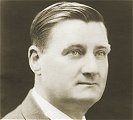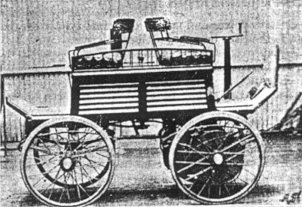Some New Features in Moto-Vehicle
Design by Thomas Hugh Parker An Excerpt from a paper
read before the Liverpool Self-Propelled Traffic Association
These first motors were series wound, and designed to run at 950 revs. per minute, and give a torque effort of 30 lbs. on the periphery of each armature with a current of 25 amperes. Forty was chosen as the number of cells, to permit of their being charged in series on the usual 110 volt circuit. The controlling of the car came next. To do this without the use of resistance coils was a difficult matter at first, but eventually turned out to be one of the simplest. Three speeds forward and one backward were found to meet all requirements, and these variations were obtained by dividing the cells into two groups of 20 each. The three forward movements were obtained as follows: First, by putting batteries in parallel, motor series, giving two miles per hour; second, batteries series, motor series, four miles per hour; and third, batteries series, motors parallel, eight miles per hour. The one backward movement, batteries parallel, motor series, with current in the armatures reversed, two miles per hour. The whole of the operations were carried out, by means of the controller mentioned at the beginning of this paper with less than one single turn of the handle. The steering gear presented itself next. I had heard a great deal of what bad been done, and had seen a car with Ackermann gear, but was dissatisfied with it, and also the double cycle head arrangement. I wanted a steering gear that would admit of a car running round a small circle with as little resistance as going straight ahead, and, after a great deal of scheming devised the idea of moving both front and hind wheels in opposite directions at the same time and through the same angle, which, both in model and practical form, worked splendidly. It enabled the car to be turned in its own length without turning the wheels under the body, and is naturally double as sensitive as a single bogie or broken axle gear. Another great advantage is that it admits of all four wheels being driven, and the load being equally divided on all four wheels. It gives a good support to the bottom of the vehicle, which in most cases is made quite flat. Each wheel can be provided with a brake. A careful examination was made of the various types of batteries, and it was decided to give the Blot Company the order for the first set. Having overcome the various points of difficulty on paper, some premises were rented in which it was just possible to build and put the car together, and as the weight of the car grew we had to shore the floor up from beneath. Six weeks from the day we commenced, the car was ready to be launched. I say launched, because it had to be lowered 18 inches into the square down some planks.
Although I did not say anything to the passengers, I decided before the journey was finished not to attempt another trip with series motors. I had the motors dismounted and had them shunt wound, and, needless w say, had to stand a good deal of chaff for such a thing, as running shunt motors in conjunction with storage batteries on tramways had years ago been green up as impracticable. The motors were hung on the third day, the connections were made, and the car run clown into the street, the result being beyond expectation. Instead of the sudden rush of current as at starting with the series motors, viz., 50 amperes, the car moved steadily away with less than 10 amperes, although the current was about the same when the rate of travelling accelerated. We then proceeded to take some tests on an incline. To do this we ran the double journey to Tettenhall and back. The work of manipulating the car was very much reduced, it only being necessary to set it to the required speed and look out for obstacles. On descending the stiffest hill the speed did not increase 5 per cent., and it was very gratifying to see the ampere meter reading 20 amperes to the good, charging the batteries instead of wearing the brake blocks away. In case of need it was found possible to bring the car to a stand from full speed ahead in 3 feet on a 10 per cent. Gradient, without the use of the brake or reversing the motors. This original car has been running almost daily for the past 18 months exactly as it was made, without a single breakdown, and has carried some of the most eminent men of the century upon it. I will now proceed to describe a few lantern slides I have had prepared under difficulties for you, showing the various stages of progress.
The next portion of the revolution puts on the main switch and locks it on, allowing the main current to flow through the armature with resistance in the circuit. This resistance is determined by the switch arm carried on the centre spindle below the discs working on an ordinary divided resistance ring, and, in this case, admits 24 points of regulation in a single turn of the handle. When stopping the motor, it follows that the maximum resistance must be put into the circuit ready for starting. Again, the main current must be broken before it is possible to break the shunt, thereby avoiding all danger of burning out the armature, which would be the case if the shunt were broken first. Further, if the motor has to be stopped and started often, as in the case of hauling machinery or hoists, cranes, and the like, the shunts can be left on, as shown, by which arrangement no damage is done to the insulation by the high voltage due to induction on breaking shunt circuits. In the controller as adapted to the electric cars the spindle carries five discs connected to levers projecting from discs. From each of these discs project eight teeth, which connect with eight bars, which are connected to the batteries and motors. The whole of the five movements are obtained in about three-quarters of a revolution of the handle, and each movement is locked and interlocked in its proper order. Figure 1 is a small electric dog-cart with double bogie steering, driven by the front wheels, and double reduction through differential gear.
Ward's omnibus weighed, with 24 passengers on, something like 7.5 tons. I saw that their difficulty was in the enormous weight, and decided to build one not to exceed 3.5 tons loaded with 14 passengers, driver, and conductor (Figure 3). This was constructed on the double-bogie principle having the batteries under the seats. It has two motors, one on each bogie, driving all four wheels. To each of the four wheels has been attached a powerful hydraulic brake working by means of a force pump near the driver's seat. The vehicle has three speeds forward and one backward, it will turn in its own length, has only two handles to manipulate it, and will run over ordinary roads 25 miles with one charge at a mean speed of eight miles an hour. Figure 4 shows an oil-car climbing a gradient of 1 in 6, upon which it is just as easily manipulated as upon the level, stopping, starting, backing, and going forward at the will of the driver, and without the aid of a brake. |







